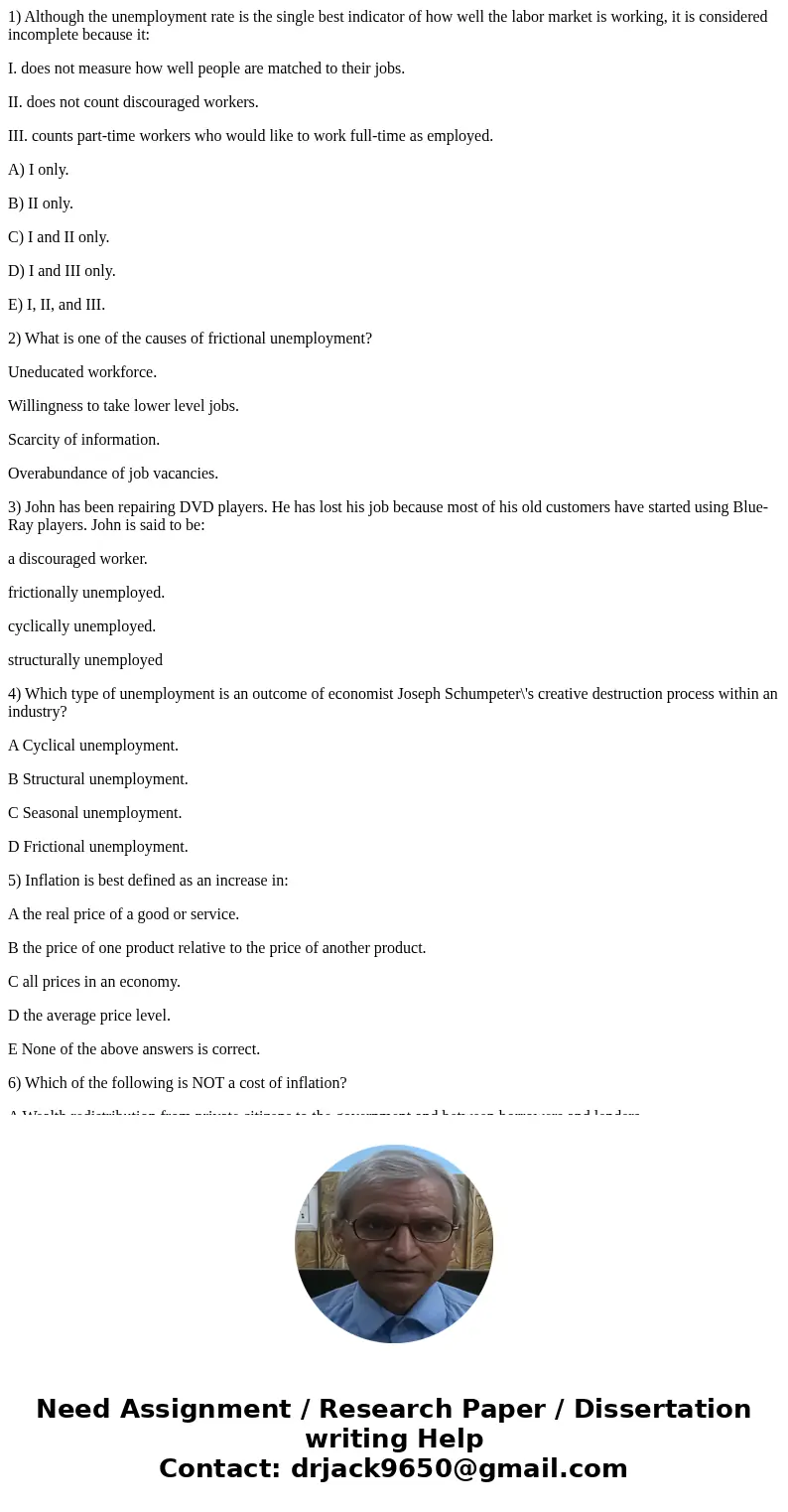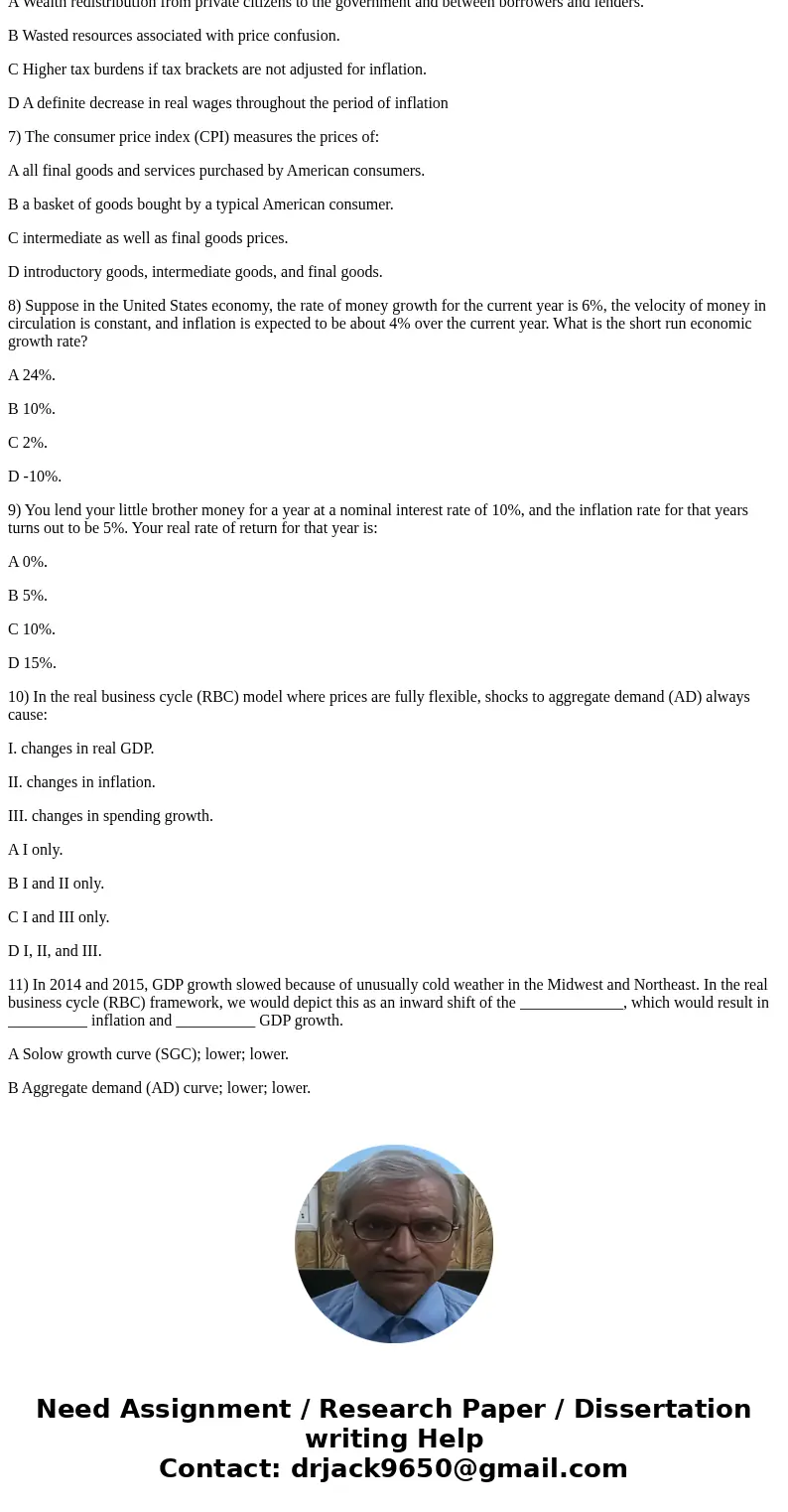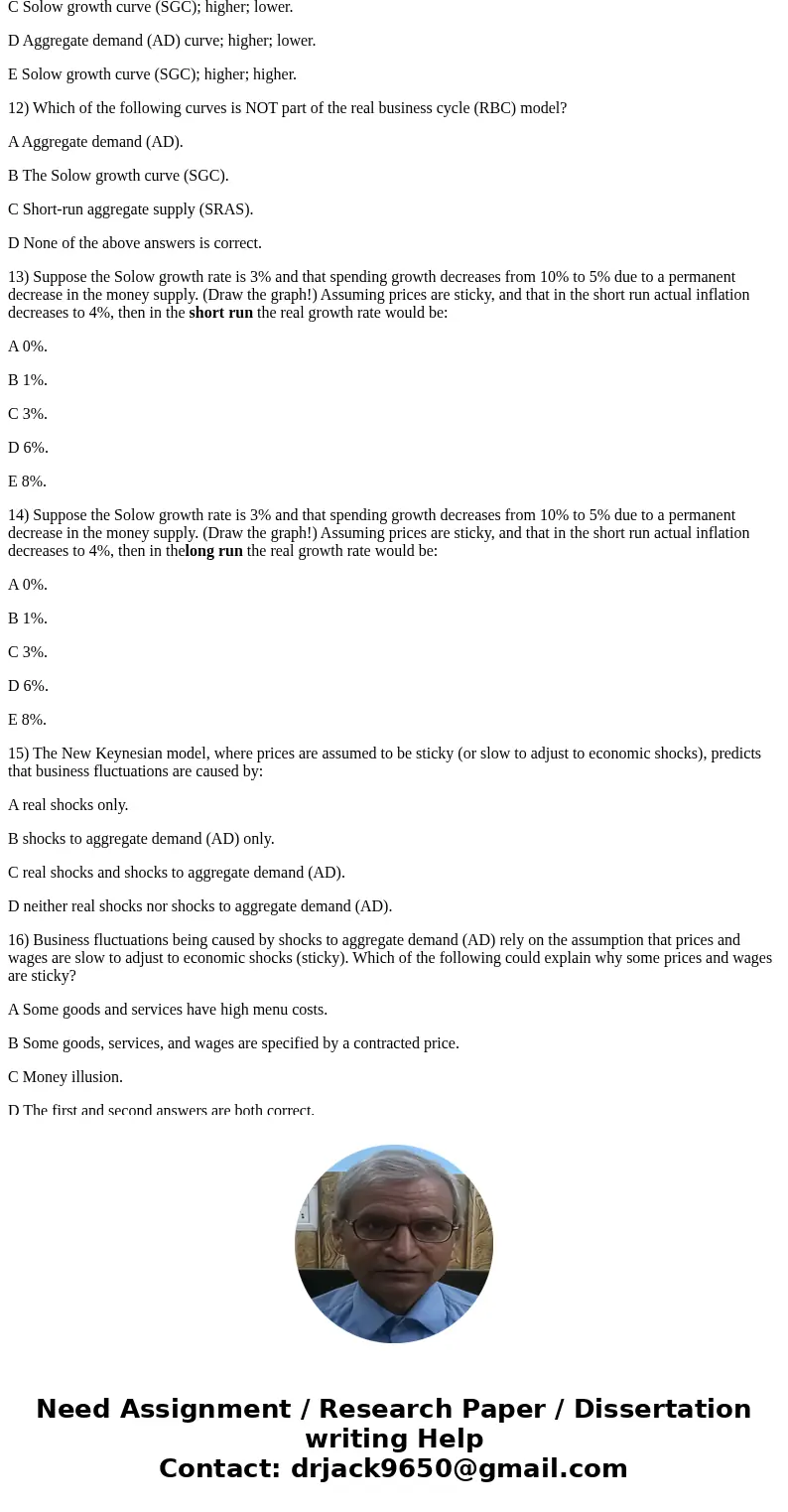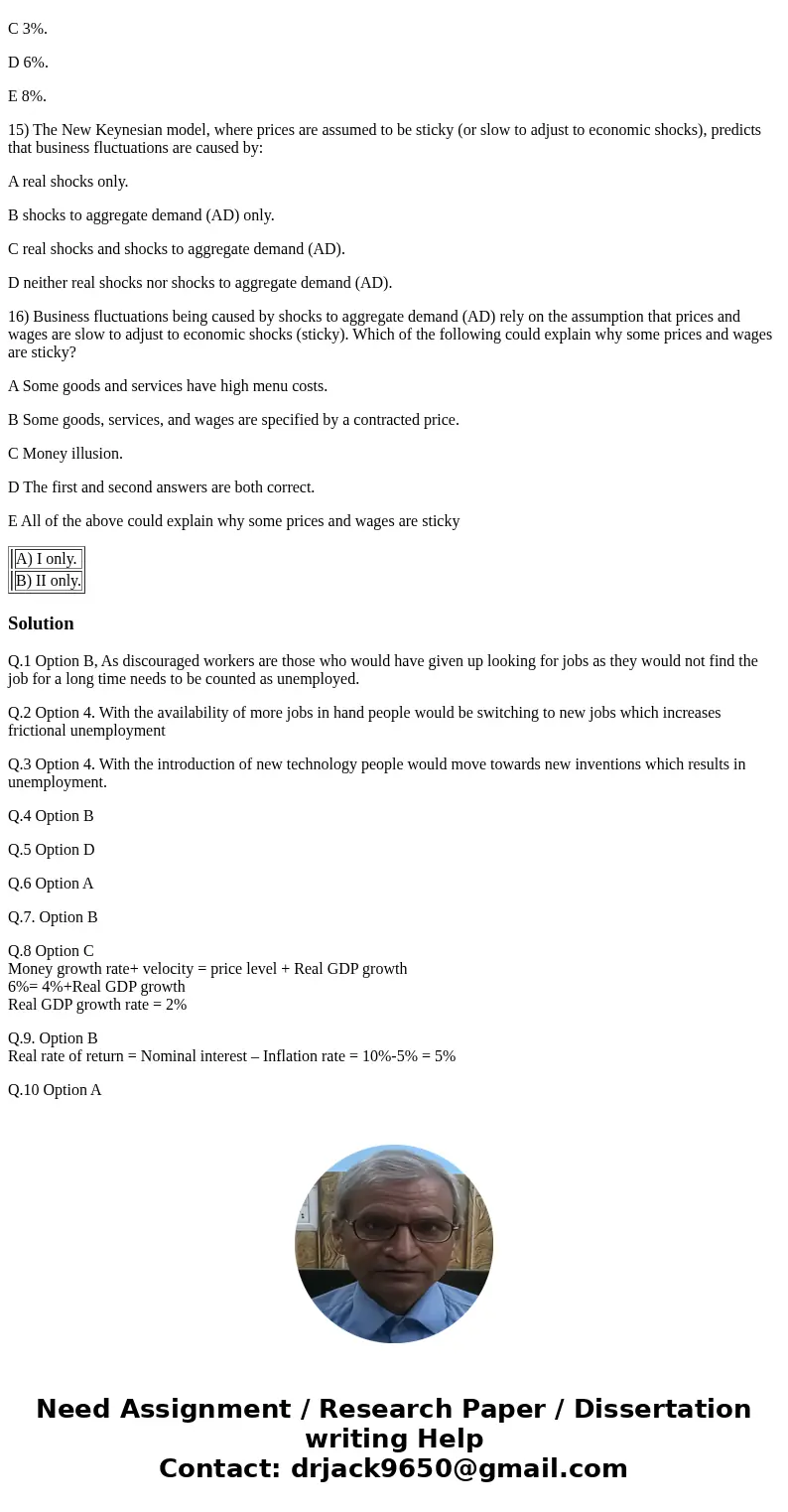1 Although the unemployment rate is the single best indicato
1) Although the unemployment rate is the single best indicator of how well the labor market is working, it is considered incomplete because it:
I. does not measure how well people are matched to their jobs.
II. does not count discouraged workers.
III. counts part-time workers who would like to work full-time as employed.
A) I only.
B) II only.
C) I and II only.
D) I and III only.
E) I, II, and III.
2) What is one of the causes of frictional unemployment?
Uneducated workforce.
Willingness to take lower level jobs.
Scarcity of information.
Overabundance of job vacancies.
3) John has been repairing DVD players. He has lost his job because most of his old customers have started using Blue-Ray players. John is said to be:
a discouraged worker.
frictionally unemployed.
cyclically unemployed.
structurally unemployed
4) Which type of unemployment is an outcome of economist Joseph Schumpeter\'s creative destruction process within an industry?
A Cyclical unemployment.
B Structural unemployment.
C Seasonal unemployment.
D Frictional unemployment.
5) Inflation is best defined as an increase in:
A the real price of a good or service.
B the price of one product relative to the price of another product.
C all prices in an economy.
D the average price level.
E None of the above answers is correct.
6) Which of the following is NOT a cost of inflation?
A Wealth redistribution from private citizens to the government and between borrowers and lenders.
B Wasted resources associated with price confusion.
C Higher tax burdens if tax brackets are not adjusted for inflation.
D A definite decrease in real wages throughout the period of inflation
7) The consumer price index (CPI) measures the prices of:
A all final goods and services purchased by American consumers.
B a basket of goods bought by a typical American consumer.
C intermediate as well as final goods prices.
D introductory goods, intermediate goods, and final goods.
8) Suppose in the United States economy, the rate of money growth for the current year is 6%, the velocity of money in circulation is constant, and inflation is expected to be about 4% over the current year. What is the short run economic growth rate?
A 24%.
B 10%.
C 2%.
D -10%.
9) You lend your little brother money for a year at a nominal interest rate of 10%, and the inflation rate for that years turns out to be 5%. Your real rate of return for that year is:
A 0%.
B 5%.
C 10%.
D 15%.
10) In the real business cycle (RBC) model where prices are fully flexible, shocks to aggregate demand (AD) always cause:
I. changes in real GDP.
II. changes in inflation.
III. changes in spending growth.
A I only.
B I and II only.
C I and III only.
D I, II, and III.
11) In 2014 and 2015, GDP growth slowed because of unusually cold weather in the Midwest and Northeast. In the real business cycle (RBC) framework, we would depict this as an inward shift of the _____________, which would result in __________ inflation and __________ GDP growth.
A Solow growth curve (SGC); lower; lower.
B Aggregate demand (AD) curve; lower; lower.
C Solow growth curve (SGC); higher; lower.
D Aggregate demand (AD) curve; higher; lower.
E Solow growth curve (SGC); higher; higher.
12) Which of the following curves is NOT part of the real business cycle (RBC) model?
A Aggregate demand (AD).
B The Solow growth curve (SGC).
C Short-run aggregate supply (SRAS).
D None of the above answers is correct.
13) Suppose the Solow growth rate is 3% and that spending growth decreases from 10% to 5% due to a permanent decrease in the money supply. (Draw the graph!) Assuming prices are sticky, and that in the short run actual inflation decreases to 4%, then in the short run the real growth rate would be:
A 0%.
B 1%.
C 3%.
D 6%.
E 8%.
14) Suppose the Solow growth rate is 3% and that spending growth decreases from 10% to 5% due to a permanent decrease in the money supply. (Draw the graph!) Assuming prices are sticky, and that in the short run actual inflation decreases to 4%, then in thelong run the real growth rate would be:
A 0%.
B 1%.
C 3%.
D 6%.
E 8%.
15) The New Keynesian model, where prices are assumed to be sticky (or slow to adjust to economic shocks), predicts that business fluctuations are caused by:
A real shocks only.
B shocks to aggregate demand (AD) only.
C real shocks and shocks to aggregate demand (AD).
D neither real shocks nor shocks to aggregate demand (AD).
16) Business fluctuations being caused by shocks to aggregate demand (AD) rely on the assumption that prices and wages are slow to adjust to economic shocks (sticky). Which of the following could explain why some prices and wages are sticky?
A Some goods and services have high menu costs.
B Some goods, services, and wages are specified by a contracted price.
C Money illusion.
D The first and second answers are both correct.
E All of the above could explain why some prices and wages are sticky
| A) I only. | |
| B) II only. |
Solution
Q.1 Option B, As discouraged workers are those who would have given up looking for jobs as they would not find the job for a long time needs to be counted as unemployed.
Q.2 Option 4. With the availability of more jobs in hand people would be switching to new jobs which increases frictional unemployment
Q.3 Option 4. With the introduction of new technology people would move towards new inventions which results in unemployment.
Q.4 Option B
Q.5 Option D
Q.6 Option A
Q.7. Option B
Q.8 Option C
Money growth rate+ velocity = price level + Real GDP growth
6%= 4%+Real GDP growth
Real GDP growth rate = 2%
Q.9. Option B
Real rate of return = Nominal interest – Inflation rate = 10%-5% = 5%
Q.10 Option A




 Homework Sourse
Homework Sourse